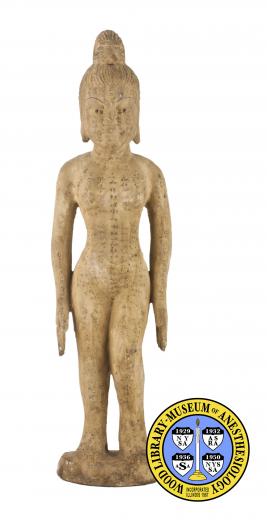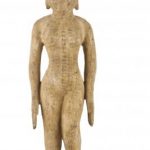Acupunture Model F
This wooden model is representative of figures once used to teach acupuncture in China. The practice of acupuncture is based on the ancient Chinese concept of yin yang balance. Yin and yang represent the interdependent opposites that exist in everything, and for good health the two must be in balance. According to traditional Chinese Medicine, a metaphysical energy called "qi", or “chi”, is believed to circulate throughout the body along invisible channels called meridians. It is thought that stagnation or problems with the flow of "qi" causes a yin yang imbalance. To restore that balance, the skin is punctured with very fine needles at acupoints. Most acupoints are found along the body’s twelve meridians. Practitioners of acupuncture use it to relieve pain and to treat a variety of health conditions.
The practice of acupuncture was developed in China and spread to other areas in Eastern Asia, including Korea and Japan, long before Europeans became familiar with it. Willem ten Rhijne, a Dutch physician who studied acupuncture for two years in Japan, wrote the first European text on the subject, De Acupunctura, published in 1683. Surgeon James Morss Churchill wrote the earliest English text on acupuncture, A Treatise on Acupuncturation, in 1823. Acupuncture became popular in the U.S. beginning in the 1970s, and continues to be used today.
Catalog Record: Acupunture Model F
Access Key: aiuv
Accession No.: 2010-09-15-2 A
Title: [Wooden acupuncture teaching model: female.]
Title variation: Alt Title
Title: Female acupuncture model.
Physical Descript: 1 model : wood ; 51.5 x 14 x 11 cm
Subject: Acupuncture Points.
Subject: Acupuncture – education.
Subject: Models, Anatomic.
Note Type: General
Notes: Descriptive title based on the WLM name for the object.
Note Type: Citation
Notes: Barnes PM, Bloom B, Nahin RL. Complementary and alternative medicine use
among adults and children: United States, 2007. National Health Statistics
Reports. 2008;12(10):10.
Note Type: Citation
Notes: Carrubba RW, Bowers JZ. The Western World’s first detailed treatise on
acupuncture: Willem Ten Rhijne’s De Acupunctura. J Hist Med Allied Sci.
1974;29(4):371-398.
Note Type: Citation
Notes: Ernst E. The recent history of acupuncture. Am J Med. 2008;121(12):1027-1028.
Note Type: Citation
Notes: Morris S. A history of acupuncture and its use in the field of pain
management. Anaesth News. February 2011;no. 283:10-12.
Note Type: Citation
Notes: White A, Ernst E. A brief history of acupuncture. Rheumatology.
2004;43(5):662-663.
Note Type: Physical Description
Notes: Model of a woman carved from a soft wood; A thin, slightly pigmented and
chalky coating, possibly gesso (a thick, water-base paint commonly formed of
plaster, chalk, or gypsum bound together with a glue), covers the surface of
the wood; Most of her features are carved but pupils/irises and eyebrows are
drawn in black ink; She stands leaning slightly on her right leg, so that the
left knee is slightly bent; Her hair is in a high bun, and she wears large
earrings; From head to foot, on the front and back, the meridians and
pressure points are represented by pin size holes and Chinese[?] characters,
marked in back ink.
Note Type: Reproduction
Notes: Photographed by Mr. William Lyle, Sept., 2010, with a similar male model.
Note Type: Historical
Notes: This model is representative of wooden figures that were used to teach
acupuncture in China. The Chinese practice of acupuncture is based on the
ancient Chinese concept of ‘yin yang’ balance. Yin and yang represent the
interdependent opposites that exist in everything, and for good health the
two must be in balance. According to traditional Chinese Medicine, a
metaphysical energy called “qi”, or “chi”, is believed to circulate
throughout the body along invisible channels called meridians. It is thought
that stagnation or problems with the flow of “qi” cause a yin yang imbalance.
Acupuncture is used to restore that balance. Acupuncture involves puncturing
the skin with very fine needles at acupoints. Most acupoints are found along
the body’s twelve meridians (Morris, 2011 ; White A, Ernst, 2004).
Note Type: Historical
Notes: Long before it became familiar to Europeans, acupuncture spread from China to
other areas in Eastern Asia, including Korea and Japan (White & Ernst, 2004).
Willem ten Rhijne, a Dutch physician who studied acupuncture for two years in
Japan, wrote the first European text on the subject, De Acupunctura,
published in 1683 (Carrubba & Bowers, 1974). Surgeon James Morss Churchill
wrote the earliest English text on acupuncture, A Treatise on Acupuncturation
in 1823. Acupuncture became popular in the U.S. beginning in the 1970s. A
2007 National Health Interview Survey found that an estimated 3.1 million
Americans had used acupuncture in the previous year (Barnes, Bloom & Nahin,
2008). Today it is commonly used as an alternative or complementary therapy
for pain. Research on acupuncture has had a number of limitations, and how
researchers and physicians interpret the results of existing research can
vary significantly. Some believe the research indicates that pain relief from
acupuncture is a reflection of the placebo effect (Ernst, 2008). Others
believe that enough data is available to suggest that acupuncture may benefit
patients with certain kinds of pain, such as low back pain, neck pain, and
tension headaches (Kelly, 2009). Most agree that more high-quality research
is necessary to draw solid conclusions as to the mechanism of action and the
efficacy of acupuncture in the management of pain. The Western name for
acupuncture is derived from Latin: acus (needle) and pungere (to prick)
(Morris, 2011).
Note Type: Exhibition
Notes: Displayed in the ASA headquarters building, on the second floor, in a display
case for Regional Anesthesia and Pain Medicine beginning in October, 2011.


